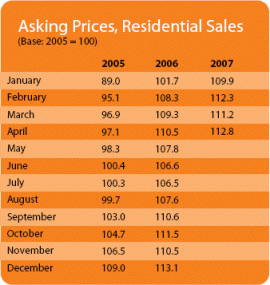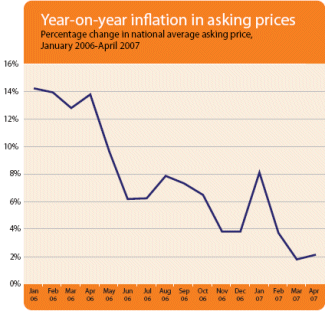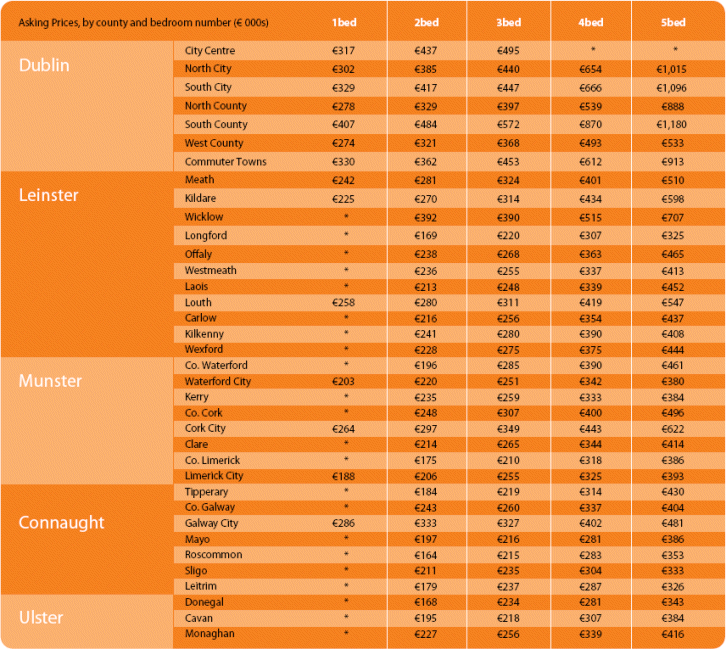House prices edging downwards, but supply response has been immediate
Daft Reports
- Ronan Lyons (House Price, Q1 2024)
- Ronan Lyons (Rental Price, Q4 2023)
- Ronan Lyons (House Price, Q4 2023)
- Ronan Lyons (Rental Price, Q3 2023)
- Ronan Lyons (House Price, Q3 2023)
- Ronan Lyons (Rental Price, Q2 2023)
- Ronan Lyons (House Price, Q2 2023)
- Ronan Lyons (Rental Price, Q1 2023)
- Ronan Lyons (House Price, Q1 2023)
- Ronan Lyons (Rental Price, Q4 2022)
- Ronan Lyons (House Price, Q4 2022)
- Ronan Lyons (Rental Price, Q3 2022)
- Ronan Lyons (House Price, Q3 2022)
- Ronan Lyons (Rental Price, Q2 2022)
- Ronan Lyons (House Price, Q2 2022)
- Ronan Lyons (Rental Price, Q1 2022)
- Ronan Lyons (House Price, Q1 2022)
- Ronan Lyons (Rental, Q4 2021)
- Ronan Lyons (House Price, Q4 2021)
- Ronan Lyons (Rental, Q3 2021)
- Ronan Lyons (House Price, Q3 2021)
- Ronan Lyons (Rental, Q2 2021)
- Ronan Lyons (House Price, Q2 2021)
- Ronan Lyons (Rental, Q1 2021)
- Ronan Lyons (House Price, Q1 2021)
- Ronan Lyons (Rental, Q4 2020)
- Ronan Lyons (House Price, Q4 2020)
- Ronan Lyons (Wealth, H2 2020)
- Ronan Lyons (Rental, Q3 2020)
- Ronan Lyons (House Price, Q3 2020)
- Ronan Lyons (Housing, July 2020)
- Ronan Lyons (Housing, June 2020)
- Ronan Lyons (Housing, May 2020)
- Ronan Lyons (Rental, Q1 2020)
- Ronan Lyons (House Price, Q1 2020)
- Ronan Lyons (Rental, Q4 2019)
- Ronan Lyons (House Price, Q4 2019)
- Ronan Lyons (Wealth, H2 2019)
- Ronan Lyons (Rental, Q3 2019)
- Ronan Lyons (House Price, Q3 2019)
- Pierre Yimbog (Rental, Q2 2019)
- Ronan Lyons (House Price, Q2 2019)
- Ronan Lyons (Wealth, H1 2019)
- Ronan Lyons (Rental, Q1 2019)
- Ronan Lyons (House Price, Q1 2019)
- Ronan Lyons (Rental, Q4 2018)
- Ronan Lyons (House Price, Q4 2018)
- Ronan Lyons (Wealth, H2 2018)
- Ronan Lyons (Rental, Q3 2018)
- Ronan Lyons (House Price, Q3 2018)
- Shane De Rís (Rental, Q2 2018)
- Ronan Lyons (House Price, Q2 2018)
- Ronan Lyons (Wealth, 2018)
- Ronan Lyons (Rental, Q1 2018)
- Ronan Lyons (House Price, Q1 2018)
- Ronan Lyons (Rental, Q4 2017)
- Ronan Lyons (House Price, Q4 2017)
- Ronan Lyons (Rental, Q3 2017)
- Ronan Lyons (House Price, Q3 2017)
- Katie Ascough (Rental, Q2 2017)
- Ronan Lyons (Wealth, 2017)
- Ronan Lyons (House Price, Q2 2017)
- Ronan Lyons (Rental, Q1 2017)
- Ronan Lyons (House Price, Q1 2017)
- Ronan Lyons (Rental, Q4 2016)
- Ronan Lyons (House Price, Q4 2016)
- Ronan Lyons (Rental, Q3 2016)
- Ronan Lyons (House Price, Q3 2016)
- Ronan Lyons (School Report, 2016)
- Conor Viscardi (Rental, Q2 2016)
- Ronan Lyons (Rail Report, 2016)
- Ronan Lyons (House Price, Q2 2016)
- Ronan Lyons (Rental, Q1 2016)
- Ronan Lyons (House Price, Q1 2016)
- Ronan Lyons (Rental, Q4 2015)
- Ronan Lyons (House Price, Q4 2015)
- Ronan Lyons (Rental, Q3 2015)
- Ronan Lyons (House Price, Q3 2015)
- Marcus O'Halloran (Rental, Q2 2015)
- Ronan Lyons (House Price, Q2 2015)
- Ronan Lyons (Rental, Q1 2015)
- Ronan Lyons (House Price, Q1 2015)
- Ronan Lyons (Rental, Q4 2014)
- Ronan Lyons (House Price, Q4 2014)
- Ronan Lyons (Rental, Q3 2014)
- Ronan Lyons (House Price, Q3 2014)
- Domhnall McGlacken-Byrne (Rental, Q2 2014)
- Ronan Lyons (House Price, Q2 2014)
- Ronan Lyons (Rental, Q1 2014)
- Ronan Lyons (House Price, Q1 2014)
- Ronan Lyons (Rental, Q4 2013)
- Ronan Lyons (House Price, Q4 2013)
- Ronan Lyons (Rental, Q3 2013)
- Ronan Lyons (House Price, Q3 2013)
- Ronan Lyons (Rental, Q2 2013)
- Ronan Lyons (House Price, Q2 2013)
- Ronan Lyons (Rental, Q1 2013)
- Ronan Lyons (House Price, Q1 2013)
- Ronan Lyons (Rental, Q4 2012)
- Ronan Lyons (House Price, Q4 2012)
- Lorcan Sirr (Rental, Q3 2012)
- Padraic Kenna (House Price, Q3 2012)
- John Logue (Rental, Q2 2012)
- Ronan Lyons (House Price, Q2 2012)
- Barry O'Leary (Rental, Q1 2012)
- Seamus Coffey (House Price, Q1 2012)
- Joan Burton (Rental, Q4 2011)
- Ronan Lyons (House Price, Q4 2011)
- Philip O'Sullivan (Rental, Q3 2011)
- Sheila O'Flanagan (House Price, Q3 2011)
- Rachel Breslin (Rental, Q2 2011)
- Constantin Gurdgiev (House Price, Q2 2011)
- Cormac Lucey (Rental, Q1 2011)
- Eoin Fahy (House Price, Q1 2011)
- Lorcan Roche Kelly (Rental, Q4 2010)
- Ronan Lyons (House Price, Q4 2010)
- John Fitzgerald (Rental, Q3 2010)
- Patrick Koucheravy (House Price, Q3 2010)
- Gary Redmond (Rental, Q2 2010)
- Jim Power (House Price, Q2 2010)
- Jill Kerby (Rental, Q1 2010)
- Brian Lucey (House Price, Q1 2010)
- Michael Taft (Rental, Q4 2009)
- Alan McQuaid (House Price, Q4 2009)
- Dr. Charles J. Larkin (Rental, Q3 2009)
- Emer O'Siochru (House Price, Q3 2009)
- Ronan Lyons (Rental, Q2 2009)
- Oliver Gilvarry (House Price, Q2 2009)
- Brian Devine (Rental, Q1 2009)
- Dr. Liam Delaney (House Price, Q1 2009)
- Gerard O'Neill (Rental, Q4 2008)
- Ronan Lyons (House Price, Q4 2008)
- Dr. Stephen Kinsella (Rental, Q3 2008)
- Moore McDowell (House Price, Q3 2008)
- Shane Kelly (Rental, Q2 2008)
- Fergal O'Brien (House Price, Q2 2008)
- Eoin O'Sullivan (Rental, Q1 2008)
- Dermot O'Leary (House Price, Q1 2008)
- Dan O'Brien (Rental, Q4 2007)
- Frances Ruane (House Price, Q4 2007)
- John McCartney (Rental, Q3 2007)
- Ronnie O'Toole (House Price, Q3 2007)
- Ronan Lyons (Rental, Q2 2007)
- Constantin Gurdgiev (House Price, Q2 2007)
- Fintan McNamara (Rental, Q1 2007)
- Rossa White (House Price, Q1 2007)
- Geoff Tucker (Rental, Q4 2006)
- Damien Kiberd (House Price, Q4 2006)
- Pat McArdle (House Price, Q3 2006)
- Marc Coleman (House Price, Q2 2006)
- David Duffy (House Price, Q1 2006)
- Austin Hughes (House Price, Q4 2005)
- David McWilliams (House Price, Q2 2005)

30th Apr 2007
Rossa White is our guest blogger, commenting on the latest Daft research on the Irish property market.
Ireland's housing market downturn in now almost nine months old. That makes its duration much longer than the blip in late-2001. At that time, more than five years ago, the market cooled for less than six months. In contrast, this slowdown may continue for the rest of the year at least.
The latest Daft.ie figures show that vendors have revised their expectations for prices, as a result of weaker demand from potential buyers. But the data also continue to suggest that the most likely outcome for prices is a period of stagnation rather than significant decline.
Asking prices increased only 2.1% year-on-year in April. That marks quite a change from a growth rate 13.8% when the market was hot in the same month one year ago. But year-on-year changes hide the turning point. In quarterly terms, prices slipped 0.5% in Q1 2007 compared with Q4 2006, an annualised rate of decline of 2%.
The Daft.ie Asking Price Index highlights that the housing market overheated in the year to mid-2006. Since then, Dublin has seen the sharpest drop in asking prices. Yet the data on final selling prices from PTSB/ESRI records that Dublin prices have held up better than in the rest of the country over the last four or five months. This implies that sellers in the Dublin area became greedier than elsewhere during the buoyant first half of 2006. Asking prices were quickly pared from an unrealistic level. The reversal in expectations is conspicuous in high-end areas of the market: Between Q3 2006 and Q1 2007, asking prices plunged 17% in Howth, 13% in Rathmines, Rathgar and Ranelagh and 10% in Clontarf, Killiney and Dalkey.
The recent slide in house-building has important implications both for the future direction of house prices and the economy as a whole. Builders and developers have reacted swiftly to falling demand thus far: it is the salient reason why overall asking prices were down only 2% in Q1 compared with the last three months of 2006. Housing starts decreased 22% year-on-year in October 2006-March 2007. The twelve-month running total has slipped to around 80,000 from a peak of 90,500 last September.
The Irish experience contrasts somewhat with US house-builders' response to the inflection point in that market in late-summer 2005. Our American counterparts kept building liberally and did not pull in their horns until the start of 2006. Housing starts were finally slashed throughout last year but developers' delayed reaction meant that the over-supply problem was relatively contained rather than calamitous.
What has happened in the US over the last 18 months may also provide a useful guide to future price trends here. Despite the biggest overhang of unsold stock in 16 years, their prices dropped only 5% year-on-year at worst.
Selling prices are unlikely to decline sharply here for a number of reasons. First, Irish builders have cut supply immediately and radically. That may help prevent a debilitating overhang of unsold stock. Second, the majority of new home developers are cash-rich after years of high retained earnings. They can afford to sit and wait for sales to materialise without having to drop prices significantly. Third, existing home-owners wishing to trade-up invariably take their homes off the market rather than sell at a discount. In some cases, they may prefer to extend or renovate their homes rather than settle for a lower price. Our guess is that prices will be unchanged to slightly down over the next six months.
But it is not easy to know when housing starts will bottom. Ireland has not witnessed a construction boom like this before. At least in the US, analysts can refer to the cyclical downturn in house-building in 1990/1991 as a guide. We no longer control interest rates, which is an added complication.
Many issues are of particular relevance to the prospects for house-building. Near term, sentiment may improve if the stamp duty matter is resolved straight after the election.
But stamp duty was not the salient reason why demand dried up. First time buyers (FTBs) neither pay stamp duty on new houses nor on second-hand homes valued at the national average. First-time buyer (FTB) demand weakened due to deteriorating affordability from rapidly rising house prices in the year to mid-2006 and from the increase in interest rates. This is reflected in rapid rent inflation, as potential buyers who could get approved for a mortgage were squeezed into the rental market (the Daft.ie index showed rents up 10.5% year-on-year in February). The challenge faced by FTBs was confirmed by the statistic that they took out 20% fewer mortgages in Q4 2006 compared with the same period a year ago. Affordability will improve with stagnant prices, but two more interest rate hikes may counter the potential boost to sentiment from stamp duty reform.
Looking ahead to 2008, other variables will determine housing demand. Increased net inward migration between 2004 and 2007 raised demand by as much as 20,000 units. Will the rate of immigration slow, as employment prospects deteriorate? To what extent was demand brought forward from the future when the market was hot in the year to mid-2006? Will the expiration of tax incentives curtail appetite for second or holiday homes, which have accounted for at least 20,000 units per annum in the last few years?
The implications of the downturn in new housing construction for the whole economy are broad. Growth in tax receipts from housing - VAT, stamp duty and capital gains - will moderate. As a result, tax revenue may miss the government forecast this year. Luckily, robust non-residential building will largely compensate for lower activity and job losses in housing. And the release of SSIA funds acts as a buffer. So the economy will be resilient in 2007. The real issue is 2008; from that perspective we hope that our forecast of 75,000 house completions next year does not prove overly optimistic.
HIGHLIGHTS:

Daft Asking Price Index (API)

Year-on-year inflation in asking prices
SNAPSHOT:

Average House Prices across Ireland in Q1 2007
